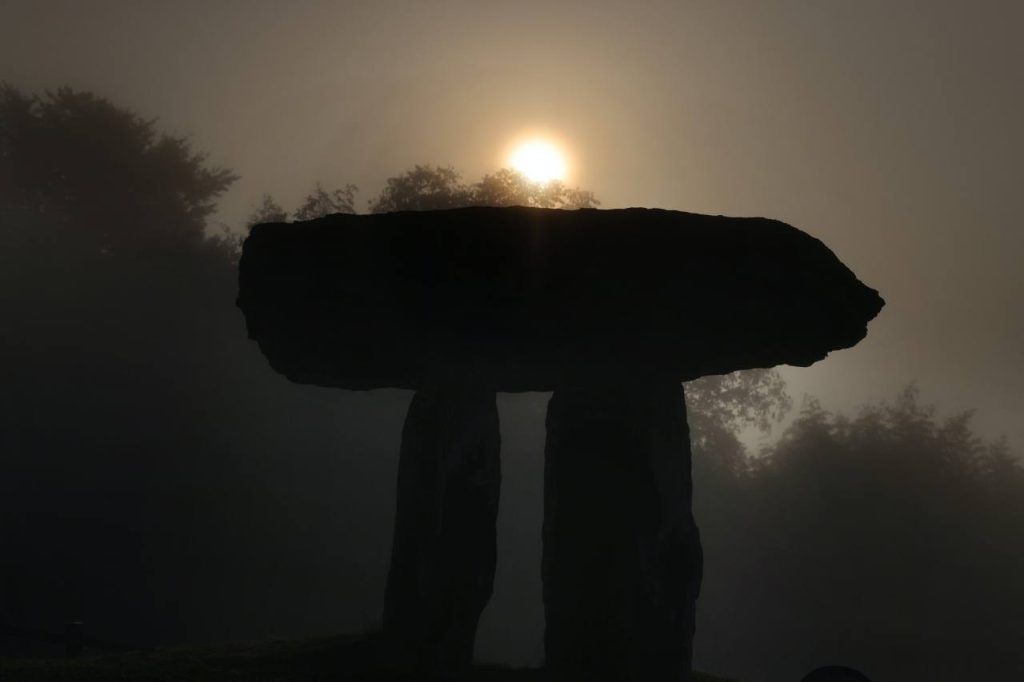January 24, 2022
SEOUL – Korea hosts an abundant number of dolmens, which stand as proof that the Korea Peninsula was a happening place during the prehistoric period.
The dolmens are megalithic burial monuments and places of worship, estimated to have been erected from the early Neolithic period into the Bronze Age.
The dolmens, similar to standing stones in other cultures, is as common as, and as Korean as kimchi in Korea. More dolmens are located in Korea than anywhere else.
Some Korean dolmens have a star chart accurately carved on them. Reading the stars was key to understanding weather patterns and agriculture heavily relied on weather patterns and timely planting for successful farming.

The sun rises over the Gochang Dosan-ri Dolmen, which is a northern-type dolmen in Gochang, North Jeolla Province. The Gochang area dolmen cluster contains the world’s biggest variety of dolmen types in a single area.Photo © Hyungwon Kang
Agricultural development during the Neolithic and Bronze Age was crucial for the growth of organized communities and population growth. Successful agriculture also enabled established civilization that is responsible for organized hierarchy in the population such as slaves and working class.
In fact, successful farming in Korea‘s fertile lands would have been essential to sustain a large enough population and labor force to build large projects like dolmens in Korea.
While dolmens are found in many places — including Africa, Europe and India — most dolmens are in Korea. Researchers have identified more than 40,000 dolmens in Korea, out of some 80,000 dolmens worldwide.
The dolmens from the early Neolithic Period and through the Bronze Age in Korea would have been erected during the Ancient Joseon period that lasted around 2,000 years. According to historical records, Ancient Joseon civilization was formed around 2333 BC, and through subsequent dynasties, and empires continues today as modern Korea.
Researchers learned that Ancient Joseon was a formidable force in East Asia with their successful rice farming, advanced textile weaving, and bronze age weapons. The 20th century archeological digs unearthed much evidence of ancient life of Koreans that have survived the passage of time including rice farming, ancient currency from neighboring kingdoms. Ancient Joseon textiles were sought-after items according to historical records.
Due to the absence of an arid climate in Korea, buried remains don’t survive very long. However, on occasion, researchers discover human remains under dolmens. More than once, DNA analysis found such remains to be non-Asian and possibly of Aryan descent, an indication that Korea has always been visited by people from various civilizations.
The Gochang, North Jeolla Province, area is known for having the highest number and biggest variety of dolmens. Indeed, it must have been a happening place back in the day — this is why Gochang calls itself the “First Capital of Korean Peninsula.”
Prehistoric cultures with successful agriculture led to a sustainable population and civilization with an organized labor force, which then enabled construction of such a significant number of Dolmen monuments.
The northern style dolmen, commonly found mostly in the northern part of Korea and former Ancient Joseon territory in North East Asia, has tall legs supporting a large flat stone table.

Ungok Dolmen, the World‘s largest dolmen, estimated to weigh 300 tons, in Ungok in Gochang, North Jeolla Province. These southern-type dolmens have burial chambers under the largest rock.Photo © Hyungwon Kang
The short-legged dolmens are called “Southern Type” as they are mostly found in southern Korea.
Then there‘s a hybrid, where burial chambers are built underground with a large block of stone, some weighing more than 100 tons, is placed on top of it.
The presence of many thoughts is one more proof that multiple cultures came to present day Korea back in the day.
The largest dolmen ever discovered is in Ungok in Gochang county.
The Ungok Dolmen is estimated to weigh some 300 tons. It is considered the largest dolmen by weight in the world. Researchers estimate thousands of men would have been required to move the 300-ton rock.
There must have been quite a gathering of locals to build such a dolmen, not to mention the management of manual labor, food and political resources required for such a project in those prehistoric times.
What is clear is that ancient Koreans knew what they were doing. The dolmens are still standing.
Researchers have concluded that many dolmens were constructed facing a body of water, usually a river or stream. When ancient visitors arrived via rivers, they would have been met with spectacular views of stone monuments.

Visitors are dwarfed next to the Pingmaebawi Dolmen, which weighs approximately 200 tons, in Hwasun Dolmen site in South Jeolla Province. Photo © Hyungwon Kang
Three Korean regions with large numbers of dolmen monuments, Gochang, Hwasun, and Ganghwa islands in South Korea, were named UNESCO World Heritage sites in 2000.
The three regions contain the highest density and greatest variety of dolmens in the world. It is a fitting coincidence that the word “dolmen” contains “dol,” which means stone in Korean.


